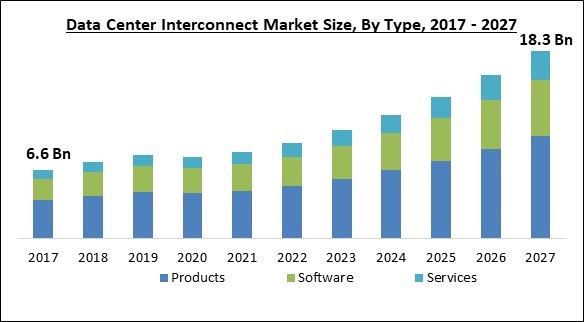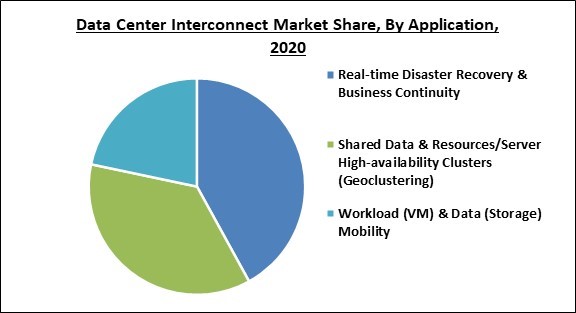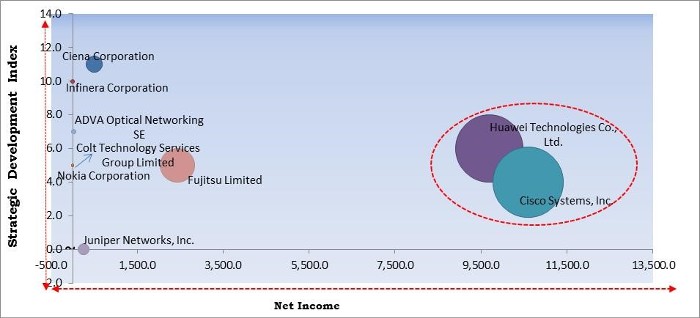The Global Data Center Interconnect Market size is expected to reach $18.3 billion by 2027, rising at a market growth of 13.9% CAGR during the forecast period.
Data centers interconnect creates a network of two or more data centers with the aim of achieving business or IT goals. They can collaborate; pass tasks between one another, and share information and resources due to this interconnectedness. Data center interconnection allows customers to connect to a variety of internet service providers, which is critical if they are in a different area. Businesses can use this to establish a strong presence both domestically and internationally, allowing them to extend their consumer base and operations. To facilitate simple data, resource sharing, and disaster recovery needs, some major enterprises utilize data center interconnect to connect their own data centers with their extended infrastructure, while others connect to partners, cloud providers, or data center operators.
The Data Center Interconnect (DCI) technology uses high-speed packet-optical communication to connect two or more data centers over short, medium, or long distances. DCI is used by some large enterprises to connect their own data centers inside their extended business infrastructures, while others connect to stakeholders to make data and resource sharing easier or to handle disaster recovery.
The requirement to connect data center assets rapidly, reliably, and cost-effectively is expanding due to the explosion of data and the rise of technologies such as AI and High-Performance Computing (HPC). Data center providers are prioritizing factors such as throughput, latency, streamlined operations and maintenance, intelligence, and security. This is because they can increase inter-data center bandwidth, lower latency, and eliminate packet loss.

In some areas, data center construction came to a halt, but this was not the case in other regions. For the interest of worker safety, construction projects in some parts of Europe have been entirely halted. In addition, pre-construction activities like permitting have been put on hold for the time being. In Southeast Asia, the impact was mixed. Singapore had imposed a temporary building halt, but Thailand was allowing projects to go, though with shortened workdays to allow workers to return home during curfews. Project management, service providers, and suppliers were all monitored for delivery capacity within the scope of construction. This allowed bottlenecks to be identified early and alternate solutions to be chosen.
The demand for colocation data center space appears to be high in the current scenario. Cloud adoption is predicted to be highest in industries such as over-the-top, video streaming, and gaming. Demand for educational access to cloud platforms has also increased dramatically.
The app architecture became so simple with the advent of web-based applications that several apps could be readily hosted on a shared server. This was accomplished without sacrificing considerable performance. However, as the number of users and the complexity of apps increased, shared hosting became obsolete. Businesses moved their apps to dedicated VPS hosting options, which were unsuitable for long periods of time and began to fail users. Owners of small businesses had little choice but to buy an entire dedicated server. The migration of the programme to the new VPS server was the first challenge they faced.
On the other hand, Businesses quickly discovered that the server's exorbitant price was not justified. Mostly, a large amount of the server's resources was not useful. The dedicated server proved to be a bad business decision because firms were paying for the full server regardless of resource consumption.
Users of data centers all throughout the world are concerned about disaster recovery. Disasters such as earthquakes, security assaults, fire outages, and other unanticipated events can all affect IT infrastructure facilities. Proper disaster recovery strategies must be in place for businesses to avoid suffering significant losses as a result of such calamities. Data center interconnection facilities are situated away from users' premises, making them less vulnerable to disasters. These facilities can be controlled remotely, enhancing their disaster recovery capabilities.
As a result, interconnection facilities are expected to become a popular backup and recovery option for enterprises since they allow them to store critical data in a remote place. Hence, the presence of a durable and secure DCI solution can ensure business continuity.
Applications use data centers to store and transport data. The size of information entering or departing a data center can vary dramatically, ranging from hundreds of Gigabits to Terabits. Data center operators face major capacity planning and network engineering issues as video, social media, and distributed application traffic explodes. New types of workloads, such as analytics, machine learning, and the Internet of Things, are putting major capacity constraints on data centers.
As a result, the networking equipment used to connect data centers must be capable of providing dependable, high-capacity connections that can be scaled to meet data center traffic's massive expansion requirements. In addition, many companies are not willing to update their existing equipment which may bring friction in connected ecosystem. Moreover, upgrading equipment requires high financial costs which are not feasible for some companies.

Based on Type, the market is segmented into Products (Packet-Switching Networking and Optical DCI), Software, and Services. The Services segment held a promising revenue share of the Data Center Interconnect Market in 2020. This is because of the various benefits of services such as accomplishing important targets and creating skillsets for strengthening their internal planning and control process to remotely manage end users' IT infrastructure/systems. The segment is expected to growth further because of the benefits of services, such as remote administration of clients' IT infrastructure and end-user systems on a proactive basis.
Based on End User, the market is segmented into Internet Content Providers/ Carrier-Neutral Providers, Communication Service Providers, Enterprises, and Government. In 2020, the Internet Content Providers/Carrier-Neutral Providers segment obtained the largest revenue share of the overall Data Center Interconnect market. This is due to the fact that the majority of data centres and thousands of servers are operated by carrier-neutral/internet content providers. These data centres need terabits of optical transport capacity over metro, regional, and long-haul distances, which can be accomplished by employing DCI to link and transmit traffic between data centres.
Based on Application, the market is segmented into Real-time Disaster Recovery & Business Continuity, Shared Data & Resources/Server High-availability Clusters (Geoclustering), and Workload (VM) & Data (Storage) Mobility. In 2020, Real-time Disaster Recovery & Business Continuity segment garnered the largest revenue share of the market. The DCI solutions make it simple for data centres located around the globe to participate in any type of business continuity and disaster recovery (BCDR) strategy. When physical barriers between data centres are removed, vital business data may be backed up, replicated, or accessed in real time, and active-active and active-standby methods can be adopted more easily. Workloads can be readily shifted or recovered in any place in the event of breakdowns or IT repair schedules. It reduces the impact of outages and disruptions on the business. It lowers the danger of data loss and reputational damage while also improving operations and reducing the likelihood of emergencies.
| Report Attribute | Details |
|---|---|
| Market size value in 2020 | USD 7.9 Billion |
| Market size forecast in 2027 | USD 18.3 Billion |
| Base Year | 2020 |
| Historical Period | 2017 to 2019 |
| Forecast Period | 2021 to 2027 |
| Revenue Growth Rate | CAGR of 13.9% from 2021 to 2027 |
| Number of Pages | 277 |
| Number of Tables | 443 |
| Report coverage | Market Trends, Revenue Estimation and Forecast, Segmentation Analysis, Regional and Country Breakdown, Competitive Landscape, Companies Strategic Developments, Company Profiling |
| Segments covered | Type, Application, End-User, Region |
| Country scope | US, Canada, Mexico, Germany, UK, France, Russia, Spain, Italy, China, Japan, India, South Korea, Singapore, Malaysia, Brazil, Argentina, UAE, Saudi Arabia, South Africa, Nigeria |
| Growth Drivers |
|
| Restraints |
|
Based on Regions, the market is segmented into North America, Europe, Asia Pacific, and Latin America, Middle East & Africa. In 2020, North America emerged as the leading region in the overall Data Center Interconnect market. This is because of the high penetration of 5G technologies, enterprise preference for server-based services, and others. In addition, the growth of the regional market would be driven by an increase in the number of secure internet servers in the United States and Canada.
Free Valuable Insights: Global Data Center Interconnect Market size to reach USD 18.3 Billion by 2027

The major strategies followed by the market participants are Product Launches. Based on the Analysis presented in the Cardinal matrix; Huawei Technologies Co., Ltd. and Cisco Systems, Inc. are the forerunners in the Data Center Interconnect Market. Companies such as Ciena Corporation Fujitsu Limited, Colt Technology Services Limited are some of the key innovators in Data Center Interconnect Market.
The market research report covers the analysis of key stake holders of the market. Key companies profiled in the report include Huawei Technologies Co., Ltd., Cisco Systems, Inc., Ciena Corporation, Infinera Corporation, ADVA Optical Networking SE, Nokia Corporation, Juniper Networks, Inc., Fujitsu Limited, Colt Technology Services Group Limited, and Extreme Networks, Inc.
By Type
By End User
By Application
By Geography
The global data center interconnect market size is expected to reach $18.3 billion by 2027.
Rise in need for disaster recovery and business continuity are driving the market in coming years, however capacity constraints limited the growth of the market.
Huawei Technologies Co., Ltd., Cisco Systems, Inc., Ciena Corporation, Infinera Corporation, ADVA Optical Networking SE, Nokia Corporation, Juniper Networks, Inc., Fujitsu Limited, Colt Technology Services Group Limited, and Extreme Networks, Inc.
The Products segment acquired the maximum revenue share in the Global Data Center Interconnect Market by Type in 2020, thereby, achieving a market value of $9.9 billion by 2027.
The North America is the fastest growing region of the Global Data Center Interconnect Market by Region in 2020, and would continue to be a dominant market till 2027.
Our team of dedicated experts can provide you with attractive expansion opportunities for your business.

